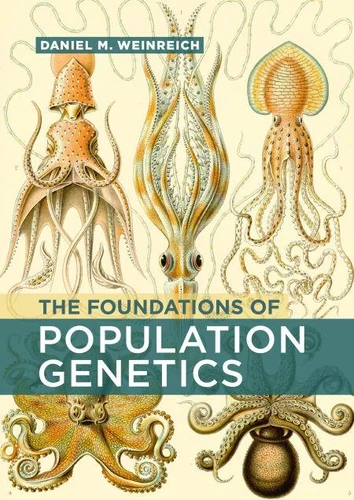The Foundations of Population Genetics
Par :Formats :
Disponible dans votre compte client Decitre ou Furet du Nord dès validation de votre commande. Le format ePub protégé est :
- Compatible avec une lecture sur My Vivlio (smartphone, tablette, ordinateur)
- Compatible avec une lecture sur liseuses Vivlio
- Pour les liseuses autres que Vivlio, vous devez utiliser le logiciel Adobe Digital Edition. Non compatible avec la lecture sur les liseuses Kindle, Remarkable et Sony
- Non compatible avec un achat hors France métropolitaine
 , qui est-ce ?
, qui est-ce ?Notre partenaire de plateforme de lecture numérique où vous retrouverez l'ensemble de vos ebooks gratuitement
Pour en savoir plus sur nos ebooks, consultez notre aide en ligne ici
- Nombre de pages254
- FormatePub
- ISBN978-0-262-37257-2
- EAN9780262372572
- Date de parution29/08/2023
- Protection num.Adobe DRM
- Taille12 Mo
- Infos supplémentairesepub
- ÉditeurThe MIT Press
Résumé
An accessible but rigorous treatment of the theoretical foundations of population genetics. Population genetics-the branch of evolutionary biology concerned with understanding how and why populations' genetic compositions change over time-rests on a well-developed theoretical foundation that draws on genetics, mathematics, and computer science. This textbook provides an approachable but rigorous treatment for advanced undergraduate and graduate students interested in building a quantitative understanding of the genetics of evolution.
Existing texts either assume very mathematically advanced readers, or avoid much of the underlying theory, instead focusing on current methods of data analysis. In contrast, The Foundations of Population Genetics develops the theory from first principles. Requiring only confidence in algebra, this self-contained, student-friendly book illustrates the conceptual framework, terminology, and methods of mathematical modeling.
It progressively introduces concepts from genetics as needed, while emphasizing biological implications throughout. As a result, readers come away with a deep understanding of the structure of population genetics without needing to master its mathematics. Connects theory with the most recent genetic data better than existing texts Features engaging real-world examples and extensive original figures Provides dozens of carefully scaffolded questions that deepen the reader's understanding of key concepts Ideal as a succinct reference for established scientists in biology, medicine, and computer science Instructor resources available
Existing texts either assume very mathematically advanced readers, or avoid much of the underlying theory, instead focusing on current methods of data analysis. In contrast, The Foundations of Population Genetics develops the theory from first principles. Requiring only confidence in algebra, this self-contained, student-friendly book illustrates the conceptual framework, terminology, and methods of mathematical modeling.
It progressively introduces concepts from genetics as needed, while emphasizing biological implications throughout. As a result, readers come away with a deep understanding of the structure of population genetics without needing to master its mathematics. Connects theory with the most recent genetic data better than existing texts Features engaging real-world examples and extensive original figures Provides dozens of carefully scaffolded questions that deepen the reader's understanding of key concepts Ideal as a succinct reference for established scientists in biology, medicine, and computer science Instructor resources available
An accessible but rigorous treatment of the theoretical foundations of population genetics. Population genetics-the branch of evolutionary biology concerned with understanding how and why populations' genetic compositions change over time-rests on a well-developed theoretical foundation that draws on genetics, mathematics, and computer science. This textbook provides an approachable but rigorous treatment for advanced undergraduate and graduate students interested in building a quantitative understanding of the genetics of evolution.
Existing texts either assume very mathematically advanced readers, or avoid much of the underlying theory, instead focusing on current methods of data analysis. In contrast, The Foundations of Population Genetics develops the theory from first principles. Requiring only confidence in algebra, this self-contained, student-friendly book illustrates the conceptual framework, terminology, and methods of mathematical modeling.
It progressively introduces concepts from genetics as needed, while emphasizing biological implications throughout. As a result, readers come away with a deep understanding of the structure of population genetics without needing to master its mathematics. Connects theory with the most recent genetic data better than existing texts Features engaging real-world examples and extensive original figures Provides dozens of carefully scaffolded questions that deepen the reader's understanding of key concepts Ideal as a succinct reference for established scientists in biology, medicine, and computer science Instructor resources available
Existing texts either assume very mathematically advanced readers, or avoid much of the underlying theory, instead focusing on current methods of data analysis. In contrast, The Foundations of Population Genetics develops the theory from first principles. Requiring only confidence in algebra, this self-contained, student-friendly book illustrates the conceptual framework, terminology, and methods of mathematical modeling.
It progressively introduces concepts from genetics as needed, while emphasizing biological implications throughout. As a result, readers come away with a deep understanding of the structure of population genetics without needing to master its mathematics. Connects theory with the most recent genetic data better than existing texts Features engaging real-world examples and extensive original figures Provides dozens of carefully scaffolded questions that deepen the reader's understanding of key concepts Ideal as a succinct reference for established scientists in biology, medicine, and computer science Instructor resources available



